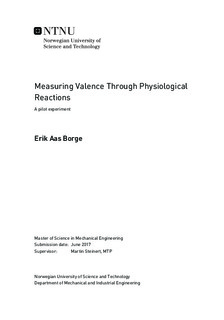Measuring Valence Through Physiological Reactions - A pilot experiment
Abstract
The much-debated topic of physiologically differentiating emotions has been of great interest to the research community in recent times. While many studies focus on facial reactions, the rest of the body is rather unexplored. This thesis takes upon the challenge of experimentally piloting and testing whether we can measure positive and negative emotional valence changes through physiological reactions in a user interaction setting. 34 adult subjects played variations of Tetris while collecting electromyography (EMG) data on the neck and forearm, and leaning distance in a seated position. Three scenarios were designed with different levels of valence and arousal (high valence-low arousal, low valence-high arousal, high valence-high arousal), upon which physiological data was analyzed. Valence was used as a within-subjects factor via self-report measurements by the Russell Affect Grid (Valence-Arousal grid) and Positive Affect Negative Affect Schedule (PANAS). Results showed that there was no statistically significant difference in physiological data between the scenarios (p=.761, p=.191 and p=.093 for EMG neck, EMG arm and leaning distance, respectively). However, the data showed tendencies in increased leaning distance from negative to positive valence. Furthermore, the thesis focuses on how one without much knowledge within the field of human experimentation can prototype and iterate one's way to such an experimental design, applying product development models to achieve this.
